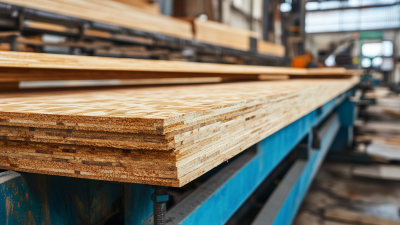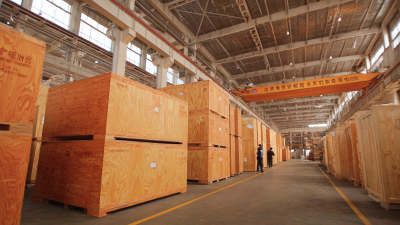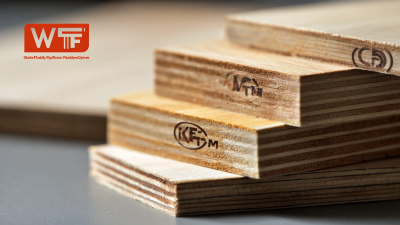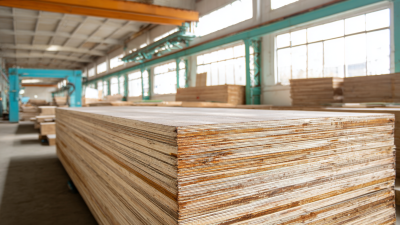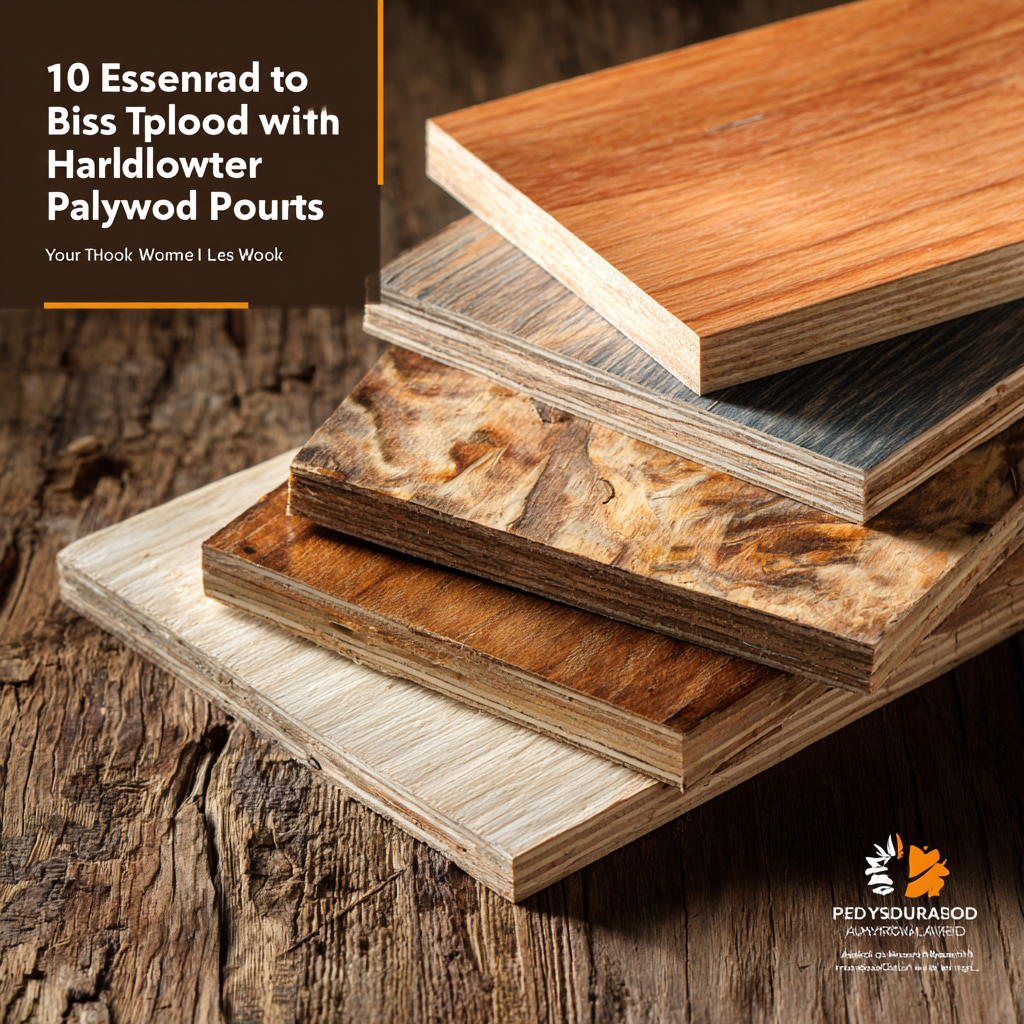 Choosing the right hardwood plywood for your projects is crucial for achieving both aesthetic and structural integrity in woodworking applications. According to the Wood Products Council, the demand for hardwood plywood is projected to grow at a CAGR of 4.5% from 2023 to 2028, driven by the increasing popularity of custom furniture and interior finishes. With a wide variety of options available, from different species of wood to varying grades and thicknesses, making an informed decision can be overwhelming.
Choosing the right hardwood plywood for your projects is crucial for achieving both aesthetic and structural integrity in woodworking applications. According to the Wood Products Council, the demand for hardwood plywood is projected to grow at a CAGR of 4.5% from 2023 to 2028, driven by the increasing popularity of custom furniture and interior finishes. With a wide variety of options available, from different species of wood to varying grades and thicknesses, making an informed decision can be overwhelming.
In this landscape, understanding the key characteristics of hardwood plywood, such as durability, moisture resistance, and visual appeal, becomes essential. A report by the Forest Products Laboratory indicates that choosing plywood made from high-quality hardwoods not only enhances the longevity of the finished product but also contributes to sustainable building practices. Whether you are a professional craftsman or a DIY enthusiast, having insight into the essential tips for selecting hardwood plywood will empower you to deliver exceptional results in your upcoming projects, ensuring both beauty and functionality.
When selecting hardwood plywood for your projects, understanding the different types and their applications is crucial. Hardwood plywood is categorized primarily into two types: hardwood face and composite back. According to the American Plywood Association, hardwood face plywood features a veneer layer made from hardwood species like oak, maple, or birch, making it ideal for furniture and cabinetry where aesthetics and durability are paramount. On the other hand, composite back plywood, which has a hardwood veneer on one side and a less expensive backing, is often used in cabinetry or internal applications where the back surface isn't visible.

In addition, it's essential to consider the grading of plywood, which is influenced by the type of wood and the quality of the veneer. The Hardwood Plywood and Veneer Association reports that graded plywood can affect overall project costs and quality. For example, A-grade panels exhibit minimal imperfections, making them suitable for high-end visual applications, while C-grade panels might carry more knots and blemishes, appropriate for hidden structures or less critical settings. By understanding these distinctions, you can make more informed decisions that align with your project's requirements.
When selecting hardwood plywood for your projects, durability should be a primary consideration. One of the key factors to assess is the grade of the plywood. Higher-grade plywood, such as A-grade, offers a smooth surface and is less likely to have defects, which can enhance the overall longevity of your project. Additionally, the number of layers in the plywood can significantly impact its durability. Plywood composed of more layers typically exhibits increased strength and resistance to warping or splitting over time.
Another important aspect to consider is the type of hardwood used in the plywood. Species like oak, maple, and birch are known for their resilience and ability to withstand wear and tear, making them ideal choices for furniture or cabinetry. Furthermore, evaluating the adhesive used in the plywood’s construction is essential. A high-quality, water-resistant adhesive will help maintain the integrity of the wood under varying environmental conditions. Keeping these factors in mind will ensure that your choice of hardwood plywood not only meets your aesthetic needs but also stands the test of time.
When selecting hardwood plywood for your projects, it's crucial to weigh the balance between price and quality. According to industry reports, the average cost of high-quality hardwood plywood ranges significantly based on the species and grade, with premium options sometimes exceeding $60 per sheet. This price reflects not only the material quality but also its durability and aesthetics, which are critical factors for both construction and design projects. In comparison, lower-grade options may offer immediate savings but can lead to more significant costs over time due to potential replacements or repairs.

Additionally, understanding the specific performance characteristics of various plywood types helps in making an informed decision. For example, marine-grade plywood, designed to resist moisture and decay, typically comes at a higher price point but offers long-lasting value for projects subjected to outdoor elements. A comprehensive analysis from market research indicates that investing in quality materials can enhance the overall integrity and beauty of a project, supporting better resale value.
In an age where DIY enthusiasts and professionals alike prioritize longevity and efficiency, recognizing the true value in hardwood plywood becomes essential for achieving both aesthetic appeal and functional resilience.
When selecting hardwood plywood for your projects, understanding the various grades is crucial to achieving the desired quality and durability. Commonly, hardwood plywood is classified into grades A, B, C, and D, with Grade A representing the highest quality.
Grade A plywood has a smooth, sanded surface with minimal imperfections, making it ideal for visible projects where aesthetics matter. This makes it suitable for furniture surfaces, cabinetry, and high-end woodworking.
On the other hand, Grade C and Grade D plywood offer more defects and can lack the same level of finish. Grade C may have some knots and minor blemishes but is still usable in hidden applications, such as in construction or for backing materials. Grade D should primarily be used where appearance is not a concern, such as for structural support or interior elements that will be covered. Recognizing these grades and their significance helps in making informed decisions that align with project requirements, ensuring both functional and visual satisfaction.
When working with hardwood plywood, having the right tools and techniques is vital to ensure a successful outcome in your projects. A study by the Wood Products Council indicates that using precision tools can increase efficiency and accuracy by up to 30%. Essential tools like a circular saw for ripping sheets, a table saw for accurate cuts, and a router for edge detailing are crucial for handling hardwood plywood effectively. Investing in high-quality blades also cannot be overstated, as they dramatically reduce the risk of tear-out and splintering, which can mar the appearance of your finished product.
In addition to the right tools, employing effective techniques is equally important. For instance, utilizing a plywood cut list helps minimize waste and maximizes yield. Research from the Woodworkers Guild of America shows that properly planning cuts can decrease waste by as much as 15%. When it comes to assembly, techniques like edge gluing for seamless joints provide not only aesthetic appeal but also structural integrity. Applying appropriate adhesives, such as polyurethane or PVA glue, can improve bonding strength, making your projects durable and long-lasting. Proper finishing techniques, including sanding and sealing, also enhance the wood's natural beauty while protecting it from damage, underscoring the importance of a meticulous approach throughout the process.
